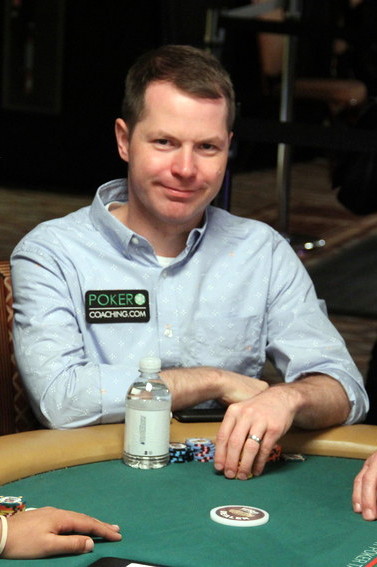Warning: Undefined array key "post_type_share_twitter_account" in /var/www/vhosts/casinonewsblogger.com/public_html/wp-content/themes/cryptocurrency/vslmd/share/share.php on line 24
 If you want to increase your poker skills and learn to crush the games, check out Jonathan Little’s elite training site at PokerCoaching.com/CardPlayer.
If you want to increase your poker skills and learn to crush the games, check out Jonathan Little’s elite training site at PokerCoaching.com/CardPlayer.
I was recently told about a hand from the final table of a live $1,000 buy-in tournament that illustrates a few critical mistakes that some players make when playing short stacked.
With blinds at 10,000-20,000 with a 20,000 big blind ante, the action folded to the small blind who started with 240,000. He was the shortest stack at the final table, but there were a few other players with between 15 and 20 big blinds.
The blind was a loose, aggressive player with 50 big blinds.
The small blind looked down at J 3
3 and decided to complete.
and decided to complete.
Limping in this situation is not a good play. J-3 is a junky hand and despite the excellent pot odds (10,000 to win 60,000), it is not strong enough to play. From out of position with a 12 big blind stack, you can be somewhat confident the big blind will apply aggression a decent amount of the time, forcing J-3 to fold.
Even if you get to see a cheap flop, you will usually flop nothing or a weak made hand that will have a difficult time confidently playing for all the money. There is also a lot of merit in simply conserving a 12 big blind stack, opting to wait for a better spot to invest your chips.
The big blind checked with 10 2
2 .
.
I am fine with this check, but if you think the small blind will raise with most of his strong hands, his limping range may be susceptible to being pushed around. I would strongly consider making it 56,000 with 10-2 offsuit with the intention of folding if the small blind goes all-in.
The flop came K 6
6 2
2 . The small blind bet 40,000 out of his 220,000 remaining stack.
. The small blind bet 40,000 out of his 220,000 remaining stack.
Again, I dislike this play. Especially in limped pots on K-x-x flops, you will find the big blind either has a pair or flush draw that is never folding, or queen-high or a worse unpaired hand, which will almost always fold to any bet.
Notice that most ace-high hands would raise or go all-in preflop, so those shouldn’t be in the big blind’s range too often. So, if you decide to bet the flop with J-3 as a low equity bluff, you should make a small bet, 20,000 into the 60,000 pot. If you think your opponent will call a 20,000 bet every time, perhaps add on a bit more, making it 26,000.
The big blind pushed all-in with bottom pair, forcing J-3 to fold.
I am fine with the all-in with bottom pair. There are plenty of hands you want to protect against (for example, J 3
3 has 30% equity) and when you happen to be beat, you have five outs to improve.
has 30% equity) and when you happen to be beat, you have five outs to improve.
This may feel like a risky all-in, but bottom pair (especially when it is a low bottom pair, such as twos) will have a difficult time continuing on the turn and river, making an all-in for the short stack’s stack ideal.
This may seem like an innocuous hand, but the small blind lost 50,000 more than he should have. He should have simply folded preflop. Even if he limped and then bet 26,000 on the flop, he would have lost 14,000 less than he did.
It is vitally important that you study and master short-stacked poker if you want to have any chance to succeed in tournaments. Sometimes you simply have to make a disciplined fold and move to the next hand.
If you want to quickly plug the 25 most common mistakes I see my students make, I put together a course called The 25 Biggest Leaks and How to Fix Them. This course is completely free inside Card Player Poker School!
When you join the Card Player Poker School (it’s free to join), you’ll also get:
- Free Downloadable Preflop Charts
- GTO Preflop Charts
- Video Classes
- Interactive Hand Quizzes
- Free Course: Master The Fundamentals
- Free Course: The 25 Biggest Leaks And How To Fix Them
- Free Training Every Week
 Jonathan Little is a two-time WPT winner and the 2024 PokerGO Cup champion with nearly $9 million million in live tournament earnings, best-selling author of 15 educational poker books, and 2019 GPI Poker Personality of the Year. If you want to increase your poker skills and learn to crush the games, check out his training site at PokerCoaching.com/cardplayer.
Jonathan Little is a two-time WPT winner and the 2024 PokerGO Cup champion with nearly $9 million million in live tournament earnings, best-selling author of 15 educational poker books, and 2019 GPI Poker Personality of the Year. If you want to increase your poker skills and learn to crush the games, check out his training site at PokerCoaching.com/cardplayer.